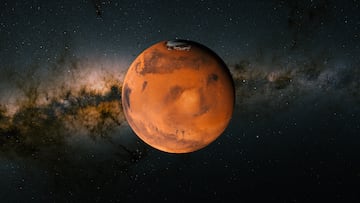This is the first species that can survive on the surface of Mars
European researchers have demonstrated that a species of lichen can survive the extreme conditions of the Red Planet.

Until recently, the conditions on Mars seemed unsuitable for any known form of life. However, a new study led by Polish scientists has shown that certain terrestrial species might actually have a real chance of adapting beyond our planet.
Specifically, for the first time, researchers have identified an organism capable of maintaining metabolic activity in a simulated Martian environment: the lichen Diploschistes muscorum, a hardy species also found in Earth’s desert and polar regions.
The study, published in the journal IMA Fungus, was conducted under controlled conditions that closely mimicked the Martian environment—that is, low atmospheric pressure, extreme temperatures, constant darkness, and most importantly, exposure to ionizing radiation, such as solar X-rays that penetrate Mars’s thin atmosphere.
For five hours, two lichen species were exposed to this hostile environment: Diploschistes muscorum and Cetraria aculeata. Only the first exhibited a positive physiological response.
"Diploschistes not only survived, but maintained active metabolism and triggered its own defense mechanisms," explained researcher Kaja Skubala, from Jagiellonian University in Krakow, lead author of the study published in IMA Fungus.
A Species with a Natural Shield
The secret to this resilience appears to lie in its structure. The lichen’s thallus contains dense crystalline deposits that act as a protective barrier against radiation. Combined with its ability to enter a dormant state without losing cellular functionality, it makes an ideal candidate for future space missions studying life in extreme environments.
Scientists believe this discovery could mark a turning point in the study of habitability beyond Earth. “Our results indicate that certain lichens can not only survive Mars-like conditions but might also become part of autonomous ecological systems in future human colonies,” the study notes.
This breakthrough strengthens the idea that extremophiles are key to understanding life’s limits in the universe. In this case, the survival of the lichen under Martian conditions equivalent to one year of intense solar exposure represents a revolution in the field of astrobiology.
Although the experiment lasted only a few hours, the researchers believe the effects simulate the long-term impact of radiation, like what a real organism would face on the Martian surface. The next step will be to extend the tests over longer periods and include new variables, such as ultraviolet radiation or Martian dust storms.
The possibility of colonizing Mars has moved from science fiction to a scientifically viable hypothesis. While many challenges remain, knowing that a terrestrial life form can remain functional in such an extreme environment gives experts hope.
“This type of research not only contributes to solar system exploration, but also helps us understand life’s incredible adaptability here on Earth,” the report concludes.
Get your game on! Whether you’re into NFL touchdowns, NBA buzzer-beaters, world-class soccer goals, or MLB home runs, our app has it all.
Dive into live coverage, expert insights, breaking news, exclusive videos, and more – plus, stay updated on the latest in current affairs and entertainment. Download now for all-access coverage, right at your fingertips – anytime, anywhere.


Complete your personal details to comment
Your opinion will be published with first and last names